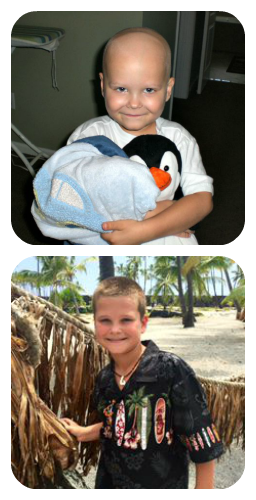My Life Changing Afternoon
Written by Chief Compliance Officer, Jacque Bos.
It was January 9, 2009 — the day that changed our lives forever. Connor, my youngest, had a fever and wasn’t feeling well so I kept him home from school. I had taken his temperature with a digital ear thermometer and it read 104.8°. This has to be wrong, I thought, but as a precaution, I called the doctor’s office anyway.
At check-in the nurse confirmed it was indeed that high. The doctor asked if she could take some blood and send it off to the lab. As we sat waiting in the exam room, Connor was so hot and miserable that he kept slipping in and out of sleep as he sat on my lap. About an hour later the doctor returned to the room, with tears filling her eyes, and explained that the blood test showed Connor’s white cell count was very high and his red cell count was very low, which is an indication of leukemia.
As she stood there saying these words I thought to myself, who is she saying this about?
Is it another child here in the clinic? It can’t be Connor. It was an out of body experience. I actually said to the doctor, who are you talking about? She responded, Connor. I’m talking about Connor. As I stood in the moment, clutching my 3-year old son, holding back the tears and trying to process what she was saying, it felt like the room was closing in on us. She then instructed me to drive directly to Wolfson’s Children’s Hospital Emergency Room and tell the admissions desk who I was, the oncologist would be expecting me. She reiterated, to please drive straight there, explaining that with his high fever and abnormal blood counts his organs could shut down and brain damage could occur.
I’m not sure how I made it to the hospital safely, I don’t even remember the drive.
The oncologist in the ER decided to take another blood test of his own, and explained that with the blood counts my doctor reported, Connor should be covered in bruises, which he wasn’t, so the doctor wasn’t sure the blood counts were accurate. My heart filled with hope. Yes that’s it, the results were wrong, they messed up in the lab, that’s got to be what happened. Unfortunately that is not what happened. The original results were correct.
Connor was admitted to the hospital and spent nine days on the 5th floor.

Through additional testing the diagnosis was narrowed down to A.L.L. (Acute Lymphoblastic Leukemia). Although we had a diagnosis, he couldn’t start chemotherapy until his fever broke, which took days. Tylenol didn’t seem to work and Motrin was not an option because it would decrease his already low red cell count. At night they would wrap him in a pouch that would pump ice water around him trying to cool his body. Connor was naturally unhappy with this process and spent most the night crying that he was cold, or he would contort his body to fit in between the pockets of ice water looking for relief and to get some sleep. It was a nightly struggle, do I leave him in that position and let him get some sleep, along with myself, or do I reach into the pouch and adjust him back into the stream of cold water? I ended up choosing to do both.
When his fever finally broke, four days later, he started chemotherapy. I remember it being a bitter sweet moment. Was I really relieved the fever broke and excited to get him started on chemotherapy? The answer was yes, because this was my new reality.
Connor responded well to the treatments and his new reality. The oncology department at Nemours provided us with a treatment roadmap that would last 3.5 years. The treatments consisted of daily oral chemotherapy and monthly IV chemotherapy, which was followed by 10 days of steroids. (And trust me there’s nothing like a starving, moody toddler to make you want to pull your hair out.) Every three months he would need to be sedated for lumbar punctures to inject chemotherapy into his spinal column. It’s hard to believe, but the routine became just that, routine, and the years flew by.
Connor is now a happy, healthy ten year old enjoying his sixth year in remission.
After years of research, trials, and testing, about 98 percent of children with A.L.L go into remission within weeks after starting treatment, and about 90 percent of those children can be cured. Patients are considered cured after 10 years in remission. There are other types of leukemia with lower survival rates, but the research and testing look promising.
It is with great pride that Team Connor Bos is forming for the 7th year to walk in the Light the Night event raising money for the Leukemia & Lymphoma Society. If you are interested in joining Team Connor Bos or would like to make a donation please give Jacque a call at our office (904) 273-9850.

